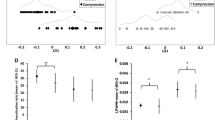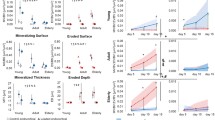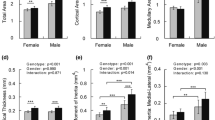Abstract
The femoral neck is a relevant and sensitive site for studying the degree of osteopenia. Engineering principles predict that bone structural parameters, like cross-sectional geometry, are important determinants of bone mechanical parameters. Mechanical parameters are also directly affected by the material properties of the bone tissue. However, the relative importance of structural and material properties is still unknown. The aim of this study was to compare bone competence and structural parameters between a murine strain showing a low bone mass phenotype, C57BL/6 (B6), and another one showing a high bone mass phenotype, C3H/He (C3H), in order to better determine the role of bone structure and geometry in bone failure behavior. Murine femora of 12- and 16-week-old B6 and 12- and 16-week-old C3H inbred strains were mechanically tested under axial loading of the femoral head. In order to assess the structural properties, we performed three-dimensional morphometric analyses in five different compartments of the mouse femur using micro-computed tomography. The mechanical tests revealed that B6 femora became stiffer, stronger, and tougher at 12–16 weeks, while bone brittleness stayed constant. C3H bone stiffness increased, but strength remained constant, work to failure decreased, and bone became more brittle. These age effects indicated that B6 did not reach peak bone properties at 16 weeks of age and C3H did reach maximal skeletal biomechanical properties before 16 weeks of age. Our investigations showed that 83% of the strength of the femoral neck in the B6 strain was explained by cortical thickness at this location; in contrast, in C3H none of the mechanical properties of the femoral neck was explained by bone structural parameters. The relative contributions of bone structural and material properties on bone strength are different in B6 and C3H. We hypothesize that these different contributions are related to differences at the ultrastructural level of bone that affect bone failure.






Similar content being viewed by others
References
WHO (1999) Osteoporosis: both health organizations and individuals must act now to avoid an impending epidemic. Press Release WHO/58. http://www.who.int/inf-pr-1999/en/pr99-58.html
Chevalley T, Rizzoli R, Nydegger V, Slosman D, Tkatch L, Rapin CH, Vasey H, Bonjour JP (1991) Preferential low bone mineral density of the femoral neck in patients with a recent fracture of the proximal femur. Osteoporos Int 1:147–154
Cummings SR, Nevitt MC, Browner WS, Stone K, Fox KM, Ensrud KE, Cauley J, Black D, Vogt TM (1995) Risk factors for hip fracture in white women. Study of Osteoporotic Fractures Research Group. N Engl J Med 332:767–773
Duboeuf F, Hans D, Schott AM, Kotzki PO, Favier F, Marcelli C, Meunier PJ, Delmas PD (1997) Different morphometric and densitometric parameters predict cervical and trochanteric hip fracture: the EPIDOS Study. J Bone Miner Res 12:1895–1902
Faulkner KG, Cummings SR, Nevitt MC, Pressman A, Jergas M, Genant HK (1995) Hip axis length and osteoporotic fractures. Study of Osteoporotic Fractures Research Group. J Bone Miner Res 10:506–508
Gnudi S, Ripamonti C, Gualtieri G, Malavolta N (1999) Geometry of proximal femur in the prediction of hip fracture in osteoporotic women. Br J Radiol 72:729–733
Cummings SR, Cauley JA, Palermo L, Ross PD, Wasnich RD, Black D, Faulkner KG (1994) Racial differences in hip axis lengths might explain racial differences in rates of hip fracture. Study of Osteoporotic Fractures Research Group. Osteoporos Int 4:226–229
Faulkner KG, Cummings SR, Black D, Palermo L, Gluer CC, Genant HK (1993) Simple measurement of femoral geometry predicts hip fracture: the study of osteoporotic fractures. J Bone Miner Res 8:1211–1217
Silver L (1995) Mouse genetics. Oxford University Press, New York
Peng Z, Tuukkanen J, Zhang H, Jamsa T, Vaananen HK (1994) The mechanical strength of bone in different rat models of experimental osteoporosis. Bone 15:523–532
Sogaard CH, Danielsen CC, Thorling EB, Mosekilde L (1994) Long-term exercise of young and adult female rats: effect on femoral neck biomechanical competence and bone structure. J Bone Miner Res 9:409–416
Turner CH, Hsieh YF, Müller R, Bouxsein ML, Rosen CJ, McCrann ME, Donahue LR, Beamer WG (2001) Variation in bone biomechanical properties, microstructure, and density in BXH recombinant inbred mice. J Bone Miner Res 16:206–213
Turner CH, Sun Q, Schriefer J, Pitner N, Price R, Bouxsein ML, Rosen CJ, Donahue LR, Shultz KL, Beamer WG (2003) Congenic mice reveal sex-specific genetic regulation of femoral structure and strength. Calcif Tissue Int 73:297–303
Turner CH, Takano Y, Hirano T (1996) Reductions in bone strength after fluoride treatment are not reflected in tissue-level acoustic measurements. Bone 19:603–607
Tuukkanen J, Peng Z, Vaananen HK (1994) Effect of running exercise on the bone loss induced by orchidectomy in the rat. Calcif Tissue Int 55:33–37
Borah B, Dufresne TE, Chmielewski PA, Johnson TD, Chines A, Manhart MD (2004) Risedronate preserves bone architecture in postmenopausal women with osteoporosis as measured by three-dimensional microcomputed tomography. Bone 34:736–746
Eckstein F, Lochmuller EM, Koller B, Wehr U, Weusten A, Rambeck W, Hoeflich A, Wolf E (2002) Body composition, bone mass and microstructural analysis in GH-transgenic mice reveals that skeletal changes are specific to bone compartment and gender. Growth Horm IGF Res 12:116–125
Ito M, Nishida A, Nakamura T, Uetani M, Hayashi K (2002) Differences of three-dimensional trabecular microstructure in osteopenic rat models caused by ovariectomy and neurectomy. Bone 30:594–598
Müller R (2003) Bone microarchitecture assessment: current and future trends. Osteoporos Int 14(Suppl 5):89–99
Müller R, Rüegsegger P (1997) Micro-tomographic imaging for the nondestructive evaluation of trabecular bone architecture. Stud Health Technol Inform 40:61–79
Rüegsegger P, Koller B, Muller R (1996) A microtomographic system for the nondestructive evaluation of bone architecture. Calcif Tissue Int 58:24–29
Alexander JM, Bab I, Fish S, Müller R, Uchiyama T, Gronowicz G, Nahounou M, Zhao Q, White DW, Chorev M, Gazit D, Rosenblatt M (2001) Human parathyroid hormone 1–34 reverses bone loss in ovariectomized mice. J Bone Miner Res 16:1665–1673
Balto K, Müller R, Carrington DC, Dobeck J, Stashenko P (2000) Quantification of periapical bone destruction in mice by micro-computed tomography. J Dent Res 79:35–40
Kapadia RD, Stroup GB, Badger AM, Koller B, Levin JM, Coatney RW, Dodds RA, Liang X, Lark MW, Gowen M (1998) Applications of micro-CT and MR microscopy to study pre-clinical models of osteoporosis and osteoarthritis. Technol Health Care 6:361–372
Müller R, Van Campenhout H, Van Damme B, Van Der Perre G, Dequeker J, Hildebrand T, Rüegsegger P (1998) Morphometric analysis of human bone biopsies: a quantitative structural comparison of histological sections and micro-computed tomography. Bone 23:59–66
Schmidt K, Schinke T, Haberland M, Priemel M, Schilling AF, Mueldner C, Rueger JM, Sock E, Wegner M, Amling M (2005) The high mobility group transcription factor Sox8 is a negative regulator of osteoblast differentiation. J Cell Biol 168:899–910
Jepsen KJ, Akkus OJ, Majeska RJ, Nadeau JH (2003) Hierarchical relationship between bone traits and mechanical properties in inbred mice. Mamm Genome 14:97–104
Tommasini SM, Morgan TG, van der Meulen M, Jepsen KJ (2005) Genetic variation in structure–function relationships for the inbred mouse lumbar vertebral body. J Bone Miner Res 20:817–827
Turner CH, Hsieh YF, Müller R, Bouxsein ML, Baylink DJ, Rosen CJ, Grynpas MD, Donahue LR, Beamer WG (2000) Genetic regulation of cortical and trabecular bone strength and microstructure in inbred strains of mice. J Bone Miner Res 15:1126–1131
Akhter MP, Cullen DM, Pedersen EA, Kimmel DB, Recker RR (1998) Bone response to in vivo mechanical loading in two breeds of mice. Calcif Tissue Int 63:442–449
Kodama Y, Umemura Y, Nagasawa S, Beamer WG, Donahue LR, Rosen CR, Baylink DJ, Farley JR (2000) Exercise and mechanical loading increase periosteal bone formation and whole bone strength in C57BL/6J mice but not in C3H/Hej mice. Calcif Tissue Int 66:298–306
Beamer WG, Sen S, Churchill GA, Rosen CJ, Donahue LR, Shultz KL, Mytar J, Turner CH, Müller R, Uchiyama T, Bouxsein ML (2001) Genetic relationships among bone phenotypes regulated by sets of quantitative trait loci (QTL) in B6C3F2 mice. J Bone Miner Res 16:S197
Ng AH, Wang SX, Turner CH, Beamer WG, Grynpas MD (2007) Bone quality and bone strength in BXH recombinant inbred mice. Calcif Tissue Int 81:215–223
Kohler T, Beyeler M, Webster D, Müller R (2005) Compartmental bone morphometry in the mouse femur: reproducibility and resolution dependence of microtomographic measurements. Calcif Tissue Int 77:281–290
Hildebrand T, Rüegsegger P (1997) A new method for the model-independent assessment of thickness in three-dimensional images. J Microsc 185:67–75
Rüegsegger P, Koller B, Müller R (1996) A microtomographic system for the nondestructive evaluation of bone architecture. Calcif Tissue Int 58:24–29
Hildebrand T, Laib A, Müller R, Dequeker J, Rüegsegger P (1999) Direct three-dimensional morphometric analysis of human cancellous bone: microstructural data from spine, femur, iliac crest, and calcaneus. J Bone Miner Res 14:1167–1174
Voide R, van Lenthe GH, Müller R (2008) Femoral stiffness and strength critically depend on loading angle—a parametric study in a mouse inbred strain. Biomed Tech. doi:10.1515/BMT.2008.019
Brodt MD, Ellis CB, Silva MJ (1999) Growing C57Bl/6 mice increase whole bone mechanical properties by increasing geometric and material properties. J Bone Miner Res 14:2159–2166
Ferguson VL, Ayers RA, Bateman TA, Simske SJ (2003) Bone development and age-related bone loss in male C57BL/6J mice. Bone 33:387–398
Boivin G, Meunier PJ (2003) The mineralization of bone tissue: a forgotten dimension in osteoporosis research. Osteoporos Int 14(Suppl 3):S19–S24
Jepsen KJ (2003) The aging cortex: to crack or not to crack. Osteoporos Int 14(Suppl 5):57–66
Wang X, Shen X, Li X, Agrawal CM (2002) Age-related changes in the collagen network and toughness of bone. Bone 31:1–7
Katz JL (1971) Hard tissue as a composite material. I. Bounds on the elastic behavior. J Biomech 4:455–473
Jamsa T, Tuukkanen J, Jalovaara P (1998) Femoral neck strength of mouse in two loading configurations: method evaluation and fracture characteristics. J Biomech 31:723–729
Cooper C (1993) The epidemiology of fragility fractures: is there a role for bone quality? Calcif Tissue Int 53(Suppl 1):S23–S26
Schnitzler CM (1993) Bone quality: a determinant for certain risk factors for bone fragility. Calcif Tissue Int 53(Suppl 1):S27–S31
Wallach S, Feinblatt JD, Carstens JH Jr, Avioli LV (1992) The bone “quality” problem. Calcif Tissue Int 51:169–172
Simmons ED Jr, Pritzker KP, Grynpas MD (1991) Age-related changes in the human femoral cortex. J Orthop Res 9:155–167
Evans F (1976) Changes in mechanical properties and histology of human compact bone. Colombus
Currey JD (1988) The effect of porosity and mineral content on the Young’s modulus of elasticity of compact bone. J Biomech 21:131–139
Boskey AL, Wright TM, Blank RD (1999) Collagen and bone strength. J Bone Miner Res 14:330–335
Burstein AH, Zika JM, Heiple KG, Klein L (1975) Contribution of collagen and mineral to the elastic-plastic properties of bone. J Bone Joint Surg Am 57:956–961
Currey JD, Foreman J, Laketic I, Mitchell J, Pegg DE, Reilly GC (1997) Effects of ionizing radiation on the mechanical properties of human bone. J Orthop Res 15:111–117
Zioupos P, Currey JD, Hamer AJ (1999) The role of collagen in the declining mechanical properties of aging human cortical bone. J Biomed Mater Res 45:108–116
Sheng MH, Baylink DJ, Beamer WG, Donahue LR, Rosen CJ, Lau KH, Wergedal JE (1999) Histomorphometric studies show that bone formation and bone mineral apposition rates are greater in C3H/HeJ (high-density) than C57BL/6J (low-density) mice during growth. Bone 25:421–429
Sheng MH, Lau KH, Beamer WG, Baylink DJ, Wergedal JE (2004) In vivo and in vitro evidence that the high osteoblastic activity in C3H/HeJ mice compared to C57BL/6J mice is intrinsic to bone cells. Bone 35:711–719
Jepsen KJ, Schaffler MB, Kuhn JL, Goulet RW, Bonadio J, Goldstein SA (1997) Type I collagen mutation alters the strength and fatigue behavior of Mov13 cortical tissue. J Biomech 30:1141–1147
Schaffler MB, Choi K, Milgrom C (1995) Aging and matrix microdamage accumulation in human compact bone. Bone 17:521–525
Wergedal JE, Sheng MH, Ackert-Bicknell CL, Beamer WG, Baylink DJ (2005) Genetic variation in femur extrinsic strength in 29 different inbred strains of mice is dependent on variations in femur cross-sectional geometry and bone density. Bone 36:111–122
Acknowledgements
This work was supported through ETH Intramural Funding (TH 00124/41-2631.5) and the Swiss National Science Foundation (FP 620-58097.99, PP-104317/1). We thank Paul Lüthi for indispensable help with our loading device.
Author information
Authors and Affiliations
Corresponding author
Rights and permissions
About this article
Cite this article
Voide, R., van Lenthe, G.H. & Müller, R. Differential Effects of Bone Structural and Material Properties on Bone Competence in C57BL/6 and C3H/He Inbred Strains of Mice. Calcif Tissue Int 83, 61–69 (2008). https://doi.org/10.1007/s00223-008-9120-y
Received:
Revised:
Accepted:
Published:
Issue Date:
DOI: https://doi.org/10.1007/s00223-008-9120-y




